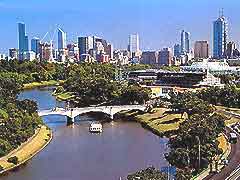Melbourne City
History
 Melbourne is the youngest of all of the 'world cities'. Melbourne grew from a tiny speculative pastoral outpost in the 1850s into a world city within a mere 30 years, reaching around 1 million people by the turn of the century. Much of this phenomenal growth was due to the gold rush - one of the biggest in the world's history, which saw a huge influx of migrants bring instant wealth and prosperity to the city. In the 1880's Melbourne was given the title 'Marvellous Melbourne', and boasted a city that rivalled the great cities of Europe and North America. The city hosted the 1880 World's Fair, in the Royal Exhibition Building, which hosted the first parliament and still stands in the magnificent Carlton Gardens. The city was, until Canberra was built in the late 1920s, from 1901 the federal capital of Australia. Although Sydney eventually grew larger, Melbourne still remains the financial, sporting and cultural capital of the nation.
Melbourne is the youngest of all of the 'world cities'. Melbourne grew from a tiny speculative pastoral outpost in the 1850s into a world city within a mere 30 years, reaching around 1 million people by the turn of the century. Much of this phenomenal growth was due to the gold rush - one of the biggest in the world's history, which saw a huge influx of migrants bring instant wealth and prosperity to the city. In the 1880's Melbourne was given the title 'Marvellous Melbourne', and boasted a city that rivalled the great cities of Europe and North America. The city hosted the 1880 World's Fair, in the Royal Exhibition Building, which hosted the first parliament and still stands in the magnificent Carlton Gardens. The city was, until Canberra was built in the late 1920s, from 1901 the federal capital of Australia. Although Sydney eventually grew larger, Melbourne still remains the financial, sporting and cultural capital of the nation.Melbourne is the capital of Victoria, Australia, and home to close to 4 million people. Many of the citizens of Melbourne live in the suburbs that east and south of the Yarra River, sprawled around Port Phillip Bay and extending as far east as Mount Dandenong.
Culture
The city is one of the world's most multi-cultural cities. For example, Melbourne has the world's third largest Greek population - and the largest outside of Greece. Only Athens and Thessalonki boast larger Greek populations. The culture contributes to the city's reputation as Australia's culinary capital, with many fine restaurants representing cuisines from around the world.
Melbourne is the undisputed sporting capital of Australia, hosting international evenst such as the 1956 Olympics, the Australian Formula 1 Grand Prix, Australian Open Tennis, 2006 Commonwealth Games and Australian Rules Football grand final. The Melbourne Cricket Ground (MCG or the 'G' as it is affectionately known here) is a world famous venue for both cricket and football.
Melbourne is Australia's comedy capital, and hosts the world's second biggest comedy festival outside of Edinburgh.
The city is Australis's home of the Arts, with internationally reknowned Arts precinct and film festival.
Melbourne is the undisputed sporting capital of Australia, hosting international evenst such as the 1956 Olympics, the Australian Formula 1 Grand Prix, Australian Open Tennis, 2006 Commonwealth Games and Australian Rules Football grand final. The Melbourne Cricket Ground (MCG or the 'G' as it is affectionately known here) is a world famous venue for both cricket and football.
Melbourne is Australia's comedy capital, and hosts the world's second biggest comedy festival outside of Edinburgh.
The city is Australis's home of the Arts, with internationally reknowned Arts precinct and film festival.
Inner Melbourne
 Inner Melbourne is a highly urban city that features strip shopping, terrace housing and high rise apartments. By contrast, outer Melbourne is one of the world's largest suburban sprawls and home to over 80% of the city's population. Many of the older suburbs still feature their original cobbled bluestone streets. Bluestone being one of the favoured building materials in Melbourne until the turn of the century.
Inner Melbourne is a highly urban city that features strip shopping, terrace housing and high rise apartments. By contrast, outer Melbourne is one of the world's largest suburban sprawls and home to over 80% of the city's population. Many of the older suburbs still feature their original cobbled bluestone streets. Bluestone being one of the favoured building materials in Melbourne until the turn of the century. Melbourne is reknowned for it's beautiful 19th century parks, that include fine examples of Victorian landscaping. Among them are the Fitzroy, Carlton and Royal Botanic Gardens, recognised as among the world's finest, as well as Albert Park - home to tha Australian Formula 1 Grand Prix. This green belt ensures that the pollution levels remain relatively low for a city of Melbourne's size.
Grand 19th century boulevardes, including Royal Parade, Victoria Parade, St Kilda Road and Dandenong Road act as gateways into the city.
What to see in Melbourne click here
Grand 19th century boulevardes, including Royal Parade, Victoria Parade, St Kilda Road and Dandenong Road act as gateways into the city.
What to see in Melbourne click here

